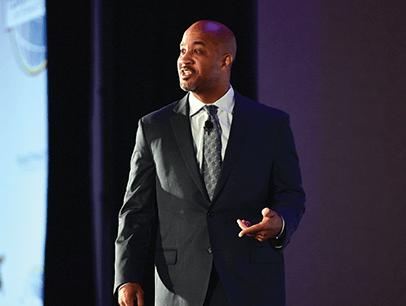
When memorable speakers take the stage, they quickly turn narratives into compelling relatable messages that grab and hold audience attention. Inevitably, these speakers use a variety of techniques aimed at activating the five basic human senses: sight, sound, taste, smell, and touch. Research shows that when multiple senses are triggered, people are more likely to engage, remember, and act on messages.
That knowledge underpins Toastmasters teaching, which has long emphasized the sensory appeal of vocal variety, gestures, props, dialogue, audience participation, images, humor, and more to augment the speaker’s words. These techniques, when combined to drive the speaker’s key message, are likely to spark a real connection between speaker and audience.
Mixing sensory techniques also helps listeners relate to presentations, because people receive and process information from the environment around them in different ways. A single approach won’t capture the attention of everyone. That concept is covered in the “Understanding Your Communication Style” project in Level 2 of the Pathways learning experience. Some people respond best to visual cues, while others learn more quickly when combining senses, such as sight, sound, and touch. Understanding that idea is applicable in structuring any type of communication, including speeches.
“Absolutely there is a science and psychology as to why presenters need to appeal to a variety of the senses and learning styles,” says Kevin Snyder, DTM, an Accredited Speaker (AS) and keynoter.
“An effective speech is not a one-way conversation—that’s a monologue. Successful speakers know they must connect with audiences through a variety of ways,” he notes.
Snyder demonstrated that awareness in his 2022 presentation to earn the AS designation. He darted onstage to snappy music and immediately invited the audience to mimic his dramatic arm gestures. He deliberately designed his speech to include a mix of sensory strategies, using poetry, songs, changing visuals, and a continuing conversation with the audience to tell his story of vulnerability and hope.
Sensory Strategies
Teresa Zumwald is a charter member of Downtown Morning Toasters in Dayton, Ohio, and CEO of Zumwald & Company, an executive communications firm. She also recommends incorporating sensory strategies into presentations. As a speechwriter and speech coach, she’s an expert on the power of spoken and unspoken messages.
According to Zumwald, strong speeches of any kind—including those aimed at the five senses—begin with intention. “If you’re just putting in sensory tactics to check a presentation box, it’s not driving your purpose,” she says. Set an intention and then decide what senses you’ll use to tell the story.
Zumwald says presentations have two purposes: to change the way an audience thinks or behaves, or both. Sensory techniques should help make those things happen, she notes.
She advises speakers to use details—don’t be vague. Details create mental pictures and stir emotions. “A lot of people don’t go to that degree, but that’s what gets people to remember,” Zumwald explains. At the same time, she notes, make every word, emotion, or sensory perception support the one main point in your speech.
Consider these sensory tactics and tips to immerse audiences in your message:
- Jump-start presentations with tactics that appeal to the minds and bodies of listeners, shifting their experience from passive listening to active participation. Open with a dramatic fact, a striking visual, a short video, an inspiring quote or song, a warm conversational style, or a poll that invites audience interaction.
- Smell is the strongest of the senses in creating memories, due to how scent is interpreted by the brain. Bring something the audience can smell and pass around, like a piece of old wood, a flower, or a specialty soap. (Remember to find out first if anyone in the audience has allergies or other issues with smells.) The same is true for taste; it’s a powerful sense that could be a problem for some people. The alternative is to arouse those senses with vivid language—describe the scent of a cozy campfire or biting into a crisp apple right from the tree.
- Inclusive language is powerful because it feels personal. If applicable, call on some people in the audience by name to ask a question or share a comment. Bring listeners into the story with “you” messages, like “Today you will learn…” or “You are curious about…”
- Nearly every listener will react to surprises. Use the power of the unexpected. For example, if you’re speaking on environmental conservation, begin with routine verbiage. Then show a slide of an intense image—taken from space—of burning tire waste sites around the world. The conflagration can be stunning.
Putting Senses in Storytelling
“You can incorporate the senses by the way you tell a story,” Zumwald, the Toastmaster from Ohio, says. Creating word pictures by arousing the senses inspires audiences to “paint a picture of something in their own minds and to feel something,” she says.
Two examples: Zumwald advised a keynote speaker reflecting on her desire to start a family by sharing a memory of spending time with her toddler nephew. She first used his name to build a character, and then described the crunchy leaves, rosy cheeks, and peals of laughter she enjoyed with him that day.
In another speech, Zumwald used the vivid sights, sounds, and feelings of Olympic ski jumping to make a business analogy. The details were so unique that the audience got the point by experiencing the thrill and life lessons of a sport they knew little to nothing about.
“Successful speakers know they must connect with audiences through a variety of ways.”
—Kevin Snyder, DTM, ASLynne Strang, DTM, a member of the Galloping Governors Advanced Toastmasters club in Fairfax, Virginia, won the 2020 District 29 Tall Tales Contest by implementing sensory techniques she’d not used in previous speech competitions. Although she had a background in drama, she’d never translated that experience into a speech. So, she tried it.
“I told the audience they would hear a story, that it was about someone special to me, and it involved love, which is a strong emotion,” Strang says. She relied heavily on facial expressions, sound effects, and props. At one point in the story, she even imitated the sounds and motion of an airplane in flight.
In a surprise ending, she tied the tale together by donning an Elton John-style feather boa and colored glasses. Strang believes her sensory antics kept the audience entertained and engaged in her improbable story.
Zumwald’s bottom line: “If the senses are going to move the story forward, I’m going to fight for them every time. If they are going to detract from the message, or are just being used for theater, then we’re going to set them aside.”
She also reminds Toastmasters of some fundamental facts. Understand the power of your own voice. Don’t compare yourself to anyone else. Keep this top of mind before writing the speech or thinking of how to enrich it with sensory tactics.
Know your own gifts, she adds. “You have certain gifts as a speaker; reflect on what those are and how you can get better. Start with what you’re doing right.”
Stephanie Darling is a former senior editor of and frequent contributor to the Toastmaster magazine.
Related Articles

Communication
Using Stories to Breathe Life into Every Speech

Presentation Skills
Cultivating Authenticity as a Speaker

Presentation Skills



 Previous
Previous

 Previous Article
Previous Article